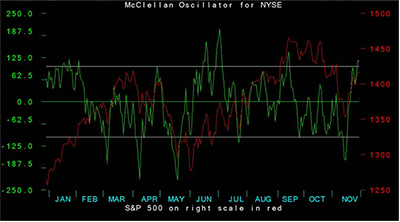“Paintballs?!”
by Jeffrey Saut, Chief Investment Strategist, Raymond James
December 3, 2012
While Hollywood has focused on huge amounts of explosives or spacecraft on a kamikaze mission to deflect asteroids, US experts say the reality could be a little simpler - and stranger. Researchers believe a very pale asteroid would reflect sunlight, and say that over time, this bouncing of photons off its surface could create enough of a force to push the asteroid off its course. However, asteroids are made of dark rock - so the team proposed using a large space based paintball gun to coat it with white paint. Sung Wook Paek, a graduate student in MIT’s Department of Aeronautics and Astronautics, says if timed just right, pellets full of paint powder, launched in two rounds from a spacecraft at relatively close distance, would cover the front and back of an asteroid, more than doubling its reflectivity, or albedo. The initial force from the pellets would bump an asteroid off course; over time, the sun’s photons would deflect the asteroid even more.
... Mark Prigg; Daily Mail (10/26/12)
Alas, if only it was that easy to “paintball” the rapidly approaching fiscal cliff. For those of you traveling the North Yungas Road in Bolivia (the most dangerous road in the world, where more than 100 people per year die by falling over the cliff) and unaware of the approaching dangerous “cliff,” let me explain. Before beginning, however, let me preface by recalling Bill Buckley’s famous lament that he would rather be governed by folks listed in the Boston phone book than Harvard professors. To be sure, there are some good politicians inside the D.C. Beltway, but not many! Of course, one of my themes is that the “players” are changing with smarter policymakers being elected, which should lead to smarter policies, but I digress.
Speaking to “the cliff,” January 1st will mark the end to last year’s temporary payroll tax cuts, gone will be select tax breaks for businesses, the alternative minimum tax (AMT) will take a larger tax bite, the Bush tax cuts end, and President Obama’s tax for the new health care law commences. Concurrently, massive spending cuts will go into effect, which according to Barron's will impact more than 1,000 government programs with major “hits” to the Defense and Medicare budgets.
More specifically, the Congressional Budget Office (CBO), whose work in my opinion has dubious validity because of its politics but nonetheless whose numbers everyone uses, states “the cliff” will have a negative $607 billion (-3.8%) hit on fiscal 2013’s GDP numbers and a $807 billion drag (-5.1%) on a calendar basis. President Obama’s budget recommendations would lift the top individual tax brackets to 39.6% from 35%, while the upper portion moves from 33% to 36%. The child tax credit/marriage-penalty provisions also lapse. Moreover, taxpayers who have been shielded from the AMT would owe extra AMT on their 2012 tax returns to be paid in calendar year 2013.
Sizing the numbers suggests the sunsetting of the upper income tax provisions raises about $75 billion (0.5% of GDP), while the reinstatement of the 2% payroll tax increases the government’s tax take by $126 billion (0.8% of GDP). Other expiring tax provisions include: the bonus depreciation allowance ($86 billion/0.5% of GDP), the largest of which permitted the 50% depreciation allowance for capital investment, as well the 100% deduction allowance for certain property placed in service during a calendar year reverts back to 50%. Other economic impacts include: the new tax for the Affordable Care Act (Obamacare) that imposes an investment income surtax of 3.8% on dividends and capital gains for high-income taxpayers ($24 billion/0.2% of GDP); automatic cuts from the Budget Control Act (often called the “budget sequestration”) that “foots” to $1.2 trillion in automatic spending cuts over a 10-year period; the ending of the extension of unemployment insurance benefits ($35 billion/0.2% of GDP); a reduction of Medicare payment rate to doctors ($15 billion/0.1% of GDP); and other revenue/spending cuts that are not specifically broken out but are estimated to be $140 billion, or 0.9% of GDP.
Plainly a “cliff dive,” for an extended period of time, would have a devastating effect on our economy. Our friends at Credit Suisse estimate a worst case impact of a -3.8% fiscal drag on nominal GDP growth next year and a best case drag of -0.9%. While the melodramatic media is replete with the horrors of “cliff diving,” one should remember that politicians ALWAYS stretch things out to the last minute. To refresh memories, recall that in the lame-duck session following the 2010 election, Congress did not enact legislation to extend the Bush tax cuts until December 17th. Moreover, Congress twiddled its thumbs until December 23rd before extending the payroll tax-cuts. If past is prelude, the same thing will happen here with either a full resolution to “the cliff,” or a staged-in solution. In past comments I have postulated that perhaps the $55 billion of tax cuts to the wealthy, of the $265 billion of Bush tax cuts, would be rescinded while the remaining $210 billion of middle-class tax cuts would be extended. Further, I think most of the mandated spending cuts will be postponed.
Clearly, the stock market believes something positive regarding “the cliff” is in the works as it continues to trade in a perky fashion. While it is true the S&P 500’s (SPX/1416.18) sprint from its November 16th oversold “low” has left it very overbought in the short-term (see chart on page 3), and in need of a rest to work-off that condition, beneath the surface there are some pretty bullish occurrences. For example, the D-J Industrial Average, the D-J Transportation Average, the NASDAQ Composite, the Russell 2000, the SPX, et all have traveled above their respective 200-day moving averages (DMAs); and, the NYSE Composite (NYA/8260.43) has actually crossed above its 50-DMA (8229.91). In technical terms, 63% of the S&P 500 stocks are above their 200-DMAs, while 56.2% are above their 50-DMAs. Further, the NYSE Advance/Decline Line is approaching a new reaction high and the number of stocks making new 52-week “highs” is expanding. Even more significant is that credit spreads are narrowing, both here and in the “club med” countries, and the Volatility Index (VIX/15.87) is below 16. Importantly, the equity markets seem to be ignoring bad news, which is amazing given the severely overbought condition. To me, all of this is bullish.
Also bullish have been the housing numbers, despite last week’s Hurricane Sandy affected numbers. While our fundamental real estate analysts downgraded the homebuilding stocks weeks ago on the belief this year’s price appreciation was ahead of the fundamentals, there is a second derivative homebuilding “play” our analysts favor named Rayonier (RYN/$49.84/Strong Buy). Another theme of mine is obesity, as the baby boomers turn 60 and move into their “diabetes years.” Playing to this theme has been DaVita (DVA/$108.00/Outperform). Last week, however, our fundamental healthcare analysts assumed research coverage of another diabetes stock named DexCom (DXCM/$13.08/Outperform). For further information on these two investment vehicles please see our analysts’ recent reports.
The call for this week: Despite the short-term overbought condition, which likely needs some time to be corrected while the SPX’s internal energy level is rebuilt as it challenges the all-important “energy level” of 1420 – 1422 often referenced in these reports, I think the upside should continue to be favored. As my friend Frederick E. “Shad” Rowe, captain of the sagacious Dallas-based money management firm of Greenbrier Partners, writes:
The stock market will always do what it must to frustrate as many investors as possible. But as to its long term direction, I have little doubt. It is up. And as to the magnitude of that move, I would say ‘very large.’ As to timing, I am a little less clear. I do believe that patience will be rewarded and that the current opportunity is so compelling that the real fool’s game remains, as it has throughout my career, attempting to time the stock market.
P.S. – I am in New York City all week seeing accounts, doing media, speaking at conferences, but most importantly attending Minyanville’s Festivus charity event to raise money for the financial education of under privileged children.

Click here to enlarge
Copyright © Raymond James










